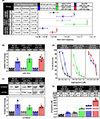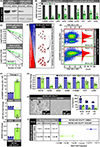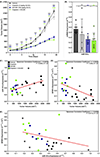The miR-181a-SFRP4 Axis Regulates Wnt Activation to Drive Stemness and Platinum Resistance in Ovarian Cancer
- PMID: 33574092
- PMCID: PMC8137569
- DOI: 10.1158/0008-5472.CAN-20-2041
The miR-181a-SFRP4 Axis Regulates Wnt Activation to Drive Stemness and Platinum Resistance in Ovarian Cancer
Abstract
Wnt signaling is a major driver of stemness and chemoresistance in ovarian cancer, yet the genetic drivers that stimulate its expression remain largely unknown. Unlike other cancers, mutations in the Wnt pathway are not reported in high-grade serous ovarian cancer (HGSOC). Hence, a key challenge that must be addressed to develop effective targeted therapies is to identify nonmutational drivers of Wnt activation. Using an miRNA sensor-based approach, we have identified miR-181a as a novel driver of Wnt/β-catenin signaling. miR-181ahigh primary HGSOC cells exhibited increased Wnt/β-catenin signaling, which was associated with increased stem-cell frequency and platinum resistance. Consistent with these findings, inhibition of β-catenin decreased stem-like properties in miR-181ahigh cell populations and downregulated miR-181a. The Wnt inhibitor SFRP4 was identified as a novel target of miR-181a. Overall, our results demonstrate that miR-181a is a nonmutational activator of Wnt signaling that drives stemness and chemoresistance in HGSOC, suggesting that the miR-181a-SFRP4 axis can be evaluated as a novel biomarker for β-catenin-targeted therapy in this disease. SIGNIFICANCE: These results demonstrate that miR-181a is an activator of Wnt signaling that drives stemness and chemoresistance in HGSOC and may be targeted therapeutically in recurrent disease.
©2021 American Association for Cancer Research.
Conflict of interest statement
Conflict of Interest: MK has equity in 3+2 Pharma LLC and is a consultant for Fuji Film Pharma and Lynk Pharmaceuticals.
Figures






References
-
- Siegel RL, Miller KD, Jemal A. Cancer statistics, 2020. CA Cancer J Clin 2020; 70: 7–30. - PubMed
-
- Choi YP, Shim HS, Gao M-Q, Kang S, Cho NH. Molecular portraits of intratumoral heterogeneity in human ovarian cancer. Cancer Lett 2011; 307: 62–71. - PubMed
-
- Dagogo-Jack I, Shaw AT. Tumour heterogeneity and resistance to cancer therapies. Nat. Rev. Clin. Oncol. 2018; 15: 81–94. - PubMed
Publication types
MeSH terms
Substances
Grants and funding
LinkOut - more resources
Full Text Sources
Other Literature Sources
Medical
Miscellaneous

